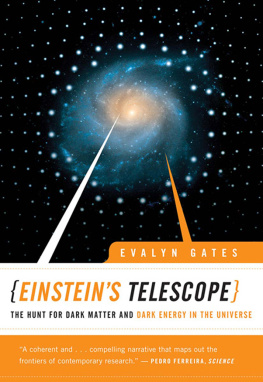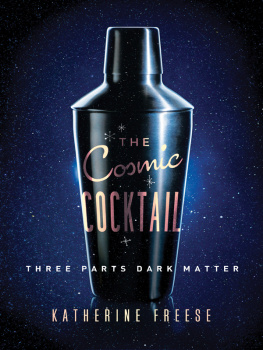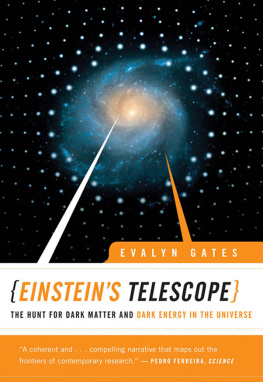My thanks to the team at Icon Books involved in producing this series, notably Duncan Heath, Robert Sharman and Andrew Furlow. Particular thanks to the late Sir Patrick Moore for being my first inspiration to take an interest in astronomy and my lecturers at the University of Cambridge for making cosmology one of the most inspiring aspects of my degree course.
Hidden depths
The universe is a big place: phenomenally big by the scale of anything we can directly experience. To be honest, we dont actually know how big it is, though the part we can see is around 91 billion light years across. Given that a light year (the distance light travels in a year) is around 9.46 trillion kilometres (5.9 trillion miles), thats a fair distance. And as the universe contains many billions of galaxies, the majority of which hold billions of stars, there is a whole lot of stuff out there. Yet in the twentieth century, two challenges to our understanding of the nature of the universe have meant that what we once thought was everything appears to be only around 5 per cent of reality.
Once, our picture of what made up the universe was simple. Ancient Greek philosopher Aristotle made use of an existing theory of four elements earth, water, air and fire and added a fifth, the quintessence or aether, which he thought made up the unchanging heavens. As astronomy and science advanced, it became clear that Aristotles model was flawed. By the nineteenth century, it was possible to detect the chemical elements that existed in the stars and they proved to be the same as those that were found on Earth. By the twentieth century, the five elements had been replaced by around 94 natural elements of the periodic table, each made up of a very small number of fundamental particles: protons, neutrons and electrons.
Although later in the twentieth century, those protons and neutrons would be discovered to have smaller components, this broad picture of everything being made of a handful of simple building blocks held. Yet a series of events was to shatter this simplistic picture. If science has one commandment, its: Things are more complicated than we thought. And the idea that all that existed in the universe could be made up from a few particles of matter, light, and four forces would not stand the test of time. Gradually, oddities began to be uncovered.
Science is frequently misunderstood as being about the collection of facts. While fact-collecting certainly happens, its not really the core of the discipline. As American biologist Stuart Firestein pointed out in his book Ignorance, its not what we know thats important to science: Working scientists dont get bogged down in the factual swamp because they dont care all that much for facts. Its not that they discount or ignore them, but rather that they dont see them as an end in themselves. They dont stop at the facts; they begin there, right beyond the facts, where the facts run out.
And the facts of what the universe was made of had begun to run out by 1933 for a Swiss astronomer named Fritz Zwicky.
Zwickys misbehaving galaxies
Zwicky, it is generally agreed, was something of a character. Born in Varna, Bulgaria in 1898, son of an influential businessman and politician of Swiss extraction, he was sent to live with his extended family in Switzerland when he was six. He studied maths and physics at Einsteins alma mater, the Swiss Federal Polytechnic (Eidgenssische Technische Hochschule) in Zurich. Although he remained a Swiss citizen, he spent most of his working life at the California Institute of Technology, where he was based from 1925.
Like his younger counterpart, English astrophysicist Fred Hoyle, Zwicky was known for the richness of his imagination, producing many ideas in astrophysics and cosmology. Inevitably some of these concepts were little more than speculation: it went with the territory. In fact, it was common in physics circles even as late as the 1970s to comment that Theres speculation, then theres more speculation, then theres cosmology. But even by cosmological standards, some of Zwickys ideas were outlandish.
Also like Hoyle, Zwickys outstanding imagination did not stop him having impressive hits. Along with German remains.
Another significant contribution by Zwicky originated in Einsteins general theory of relativity. This theory describes the interaction between matter and spacetime (see page ) matter distorts the spacetime near it, producing the effects we describe as gravity. Inherent in general relativity is the idea that massive objects cause rays of light to bend, as the space the light passes through is warped by the matter. As American physicist John Wheeler put it, Spacetime tells matter how to move; matter tells spacetime how to curve. Zwicky realised that this effect was similar to that produced by an ancient optical device the lens.
Lenses (given the Latin name of a lentil because they are similarly shaped) bend the path of light by different amounts, depending on the thickness of the glass the light hits. The circular shape modifies the lights path by an increasing amount as we get further from the centre, because the glass is at a more extreme angle to the light, meaning that the lens collects together rays of light hitting it at various points and focuses them.
Thinking about the way a lens worked, Zwicky realised that an extremely massive object such as a galaxy could have a similar effect on passing light. If we imagine light coming from a distant object behind a galaxy, some of the light would attempt to pass around the edge of the galaxy. But the huge mass of the galaxy would bend the light beams inwards from all sides, focusing the light a great distance ahead of the galaxy. If we were positioned appropriately, and the image was cast in such a way that it wasnt washed out by the light from the galaxy, this gravitational lensing would mean that we could see a very distant object by using the intervening galaxy as if it were the lens in a vast telescope.

Light from a distant object is focused by an intervening galaxy acting as a gravitational lens.
Adapted from an image released by ESA/ATG medialab
Gravitational lensing involves something we can see a galaxy having a gravitational effect on passing light. But Zwickys greatest discovery would involve a gravitational effect that appeared to come from an invisible source. He had been studying a collection of galaxies known as the Coma Cluster. Galaxies are vast bodies our own Milky Way, for example, a fairly average large galaxy, is over 150,000 light years across. Containing billions of stars each, galaxies have a huge gravitational influence on their surroundings and as a result readily form clusters with other galaxies, held together by gravity.
The Coma Cluster is located about 320 million light years away from us and contains over 1,000 galaxies as the nearest neighbouring cluster to our local cluster, the one occupied by the Milky Way (the Virgo Supercluster), it has inevitably been of great interest to astronomers. Yet when Zwicky started to analyse the behaviour of the cluster in 1933, he found something odd. It should not have held together.
On the whole, things in the universe spin around. Were familiar with this being the case in our own solar system. The Earth rotates on its axis once a day and orbits the (rotating) Sun once a year, as do the other planets, each with their own distinct period. Planets, moons, stars, solar systems, galaxies, galactic clusters all spin around. This is a result of the way that they formed. These structures were produced from clouds of gas and dust, pulled together by the force of gravity. If those clouds were perfectly symmetrically dispersed through space, then they could collapse without developing a spin. But in reality, it is far more likely that there will be more matter on one side than the other. As the matter is attracted inwards, the result of this imbalance is that the whole collection of stuff begins to rotate.

















